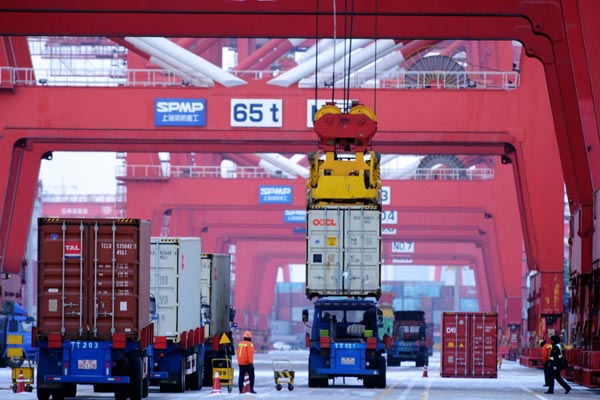In govt's policy plans, stability is the key
 |
|
A ship loads containers at a terminal in Qingdao, Shandong province. [Photo/China Daily] |
The government's economic plans for 2017, presented at the recently concluded National People's Congress, China's top legislature, indicate that, despite more emphasis on containing financial risks, solid economic growth remains central to the economic and financial "stability", which the government considers essential in the run-up to the 19th National Congress of the Communist Party of China, scheduled for the fall of this year.
The GDP growth target of "around 6.5 percent, slightly higher if possible in practice" will require continued accommodative macroeconomic policy and increases in the credit to GDP ratio. On the fiscal side, the issuance of special local government bonds and use of "special funds" are likely to raise the cash fiscal deficit to 4.3 percent of GDP this year. In addition, quasi-fiscal activity continues apace in order to finance infrastructure spending.
The monetary targets and plans imply a slightly less accommodative stance than last year, with overall credit growth, excluding equity and adjusted for local government bond issuance, targeted at 14.8 percent, only slightly less than in 2016.
China's central bank will need to walk a fine line to achieve this while also firming up monetary conditions to contain leverage and risks in financial markets as well as to respond to higher US interest rates and the resulting pressure on the foreign exchange market. Following recent increases in inter-bank rates engineered by the central bank, we expect it to raise inter-bank interest rates further and to carefully tighten regulation in shadow banking, especially in asset management. But we do not expect increases in benchmark interest rates any time soon.
Given the pressure on the foreign exchange market, we expect the authorities to continue to intervene to prevent the yuan from depreciating by a large margin, while clamping down on financial outflows, if needed with forceful measures.
Senior officials have recently stressed the need to "avoid property market fluctuations", that is, to avoid too much strength as well as too much weakness. The central government has asked local governments to "contain excessive home price rises in hot cities", through measures such as increasing land supply and tightening housing purchase restrictions, while instructing local governments in smaller cities to stimulate housing sales. However, property tax legislation is still not on the legislative agenda.
The central government aims to remove another 50 million tons of excess capacity in steel and 150 million tons in coal mining this year, following a good start last year, while continuing to support the resettlement of affected employees, using special "adjustment funds" and fiscal transfers.
As experiments with "mixed ownership" reforms of State-owned enterprises continue, the government is also allowing private capital to take a minority share in SOEs in sectors dominated by them, in part in order to meet the need for financing. It has promised to open the competitive areas of the power, oil and gas sectors to private enterprises. But given the lack of progress in this area over the last 10 years, it remains to be seen how much progress will be made this time around. Indeed, in our view, the progress on levelling the playing field between SOEs and other companies remains unconvincing.
China is a major beneficiary of globalization, and the government wants this phenomenon to continue despite the increasing international headwinds. Following the US' withdrawal from the Trans-Pacific Partnership agreement, the Chinese government has promoted free trade and investment, including establishing a free trade area of the Asia Pacific region.
And amid complaints by Western companies and governments about the lack of access to markets in China, the government has promised to further open up to foreign companies and financial institutions, following moves earlier this year to give them easier access. It has also vowed to further relax investment restrictions on foreign investors and encourage overseas-invested companies to list and issue bonds in China.
In conclusion, the government's economic plans for this year show that, despite more emphasis on containing financial risks, solid economic growth is still a key objective. In all, the planned macro stance is somewhat less generous than last year.
The author is head of Asia economics at Oxford Economics.




















